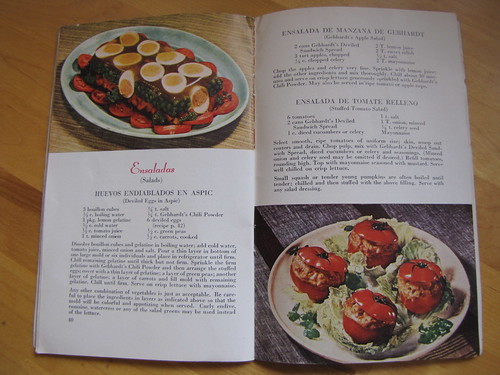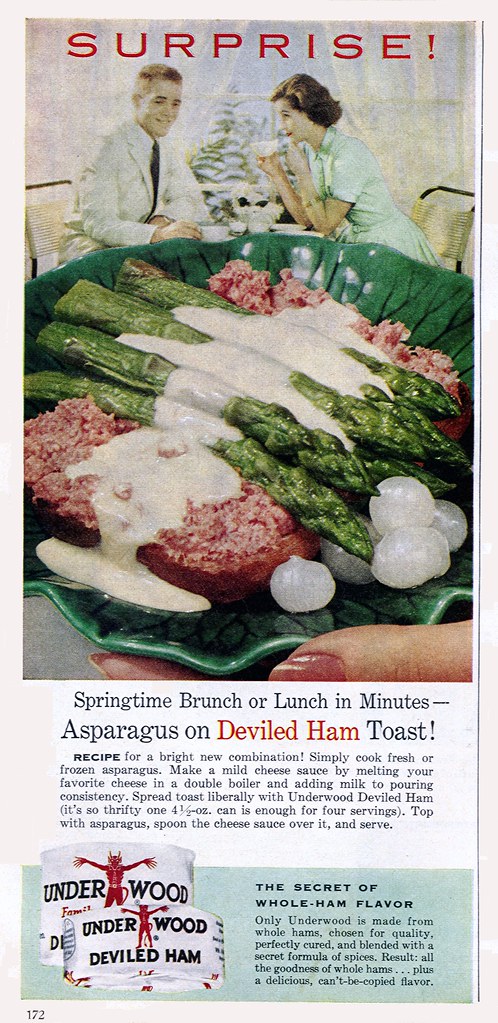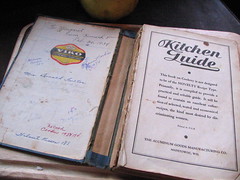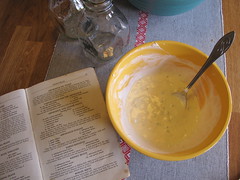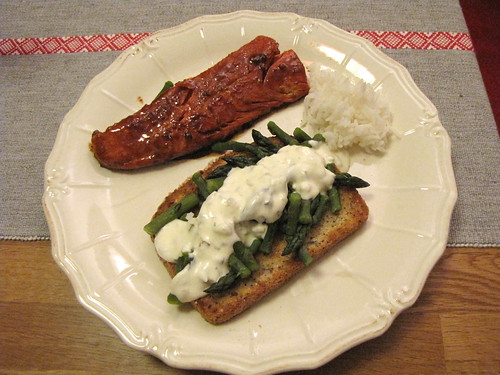Mexican Cookery for American Homes
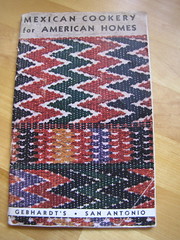 Last week I acquired a copy of a small cookbook, Mexican Cookery for American Homes, published in 1936 by the Gebhardt Chili Powder Company of San Antonio, Texas. This was an updated version of a 1923 cookbook also published by Gebhardt. (In 1908, Gebhardt published another book called Mexican Cooking; there’s a reprint now available.)
Last week I acquired a copy of a small cookbook, Mexican Cookery for American Homes, published in 1936 by the Gebhardt Chili Powder Company of San Antonio, Texas. This was an updated version of a 1923 cookbook also published by Gebhardt. (In 1908, Gebhardt published another book called Mexican Cooking; there’s a reprint now available.)
In the early 20th century, Mexican food has become a staple of the American diet, though it’s been Americanized to some extent. It’s no longer exotic in any way. We all know enchiladas, tacos, and tamales. In 1936, however, Mexican food could still be a bit more of an unusual treat unless you lived in areas such as the Southwest U.S.. The cookbook’s foreword alludes to this when it says “Mexican foods are as interesting and appetizing as they are exotic” and stresses that “Americanized recipes are also included.”
Indeed they are. Along with the enchiladas and tacos, the book includes Sopa a la Creole (Creole Gumbo), Torta de Carne Enchilada (Chili Meat Loaf), Rarebit a la Mexicana (three versions of Mexican Rarebit — basically, Welsh Rabbit with with such additions as chili powder, corn, and Gebhardt’s Deviled Sandwich Spread), Huevos Endiablados en Aspic (Deviled Eggs in Aspic) and Chili Scrapple.
My favorite recipe, for its sheer silliness, is the recipe for Gebhardt’s Chili con Carne:
GEBHARDT’S CHILI CON CARNE
(Gebhardt’s Chili with Meat)No. 2 can Gebhardt’s Chili con Carne
Place the can of Gebhardt’s Chili con Carne, either plain or with beans, in a saucepan and cover with hot water. Allow to boil gently for 20 minutes. Turn into hot bowls and serve at once.
Yes, you read that correctly. This recipe is telling you to heat up a can of chili. If that’s not enough, it’s telling you to boil it unopened. That’s not something we see much in modern cookbooks, is it? (Though I admit to making dulce de leche that way once or twice — you boil a can of sweetened condensed milk for 3 hours. Problem is, if the pan runs dry, your can explodes.)
Many of the other recipes are a bit more complex and don’t require products out of a Gebhardt can, though most of them do require Gebhardt chili powder, which makes sense since that was the company’s flagship product. This week, I made Enchiladas, Mexican Style and Salsa de Chili from this cookbook. I’ll report how those recipes turned out in my next post. In the meantime, however, you might enjoy Gebhardt’s recipe for tacos.
TACOS
Place slices of cooked meat of chicken on a tortilla, spread with pickle relish and fold over, fastening each tacos with two toothpicks so as to hold together. Fry in deep hot fat (390 F.) or toast on a hot griddle, until throughly (sic.) heated and a golden brown in color.
Have ready a salad of shredded lettuce and chopped tomatoes dressed with Gebhardt’s Salad Dressing (page 39). Top each hot tacos with the salad and serve at once.
Note: Tacos is the Mexican’s Sandwich. It is generally thought of as made of roast meat of chicken, either sliced or minced but cheese and sweet fillings are rapidly gaining in popularity. The Mexican enjoys his Tacos and Hot Chocolate as does the American his Doughnuts and Coffee.
An interesting thing about the Gebhardt recipe is how the text uses the word “tacos” — it uses it as a singular noun: “Top each hot tacos with the salad.” Other old cookbooks and magazines from before this time don’t do this. For example, Table Talk, “The American Authority upon Culinary Topics and Fashions of the Table,” discussed Mexican cooking in October, 1913 in the article “Mexican Kitchens and Cooks,” and said: “A taco is the Mexican sandwich; it is a tortilla in which are rolled meat, frijoles, salsa, or nata (curd of boiled milk).”
As a bonus, here’s one more early 20th century recipe for tacos, this one from the Castelar Créche Cook Book, published in Los Angeles in 1922:
TACOS
Put the tortillas in boiling lard and put in tomatoes mashed with onion and bits of garlic, cheese, cooked pork meat, alligator pear, salt and strips of peeled chiles. Roll and cover with a clean tortilla, hold together with toothpick and fry in very little lard, in fact, just enough not to burn. To eat, take off the first tortilla.—Carlota L. Algara.
Next post — The Enchiladas, Mexican Style experiment. Stay tuned.

